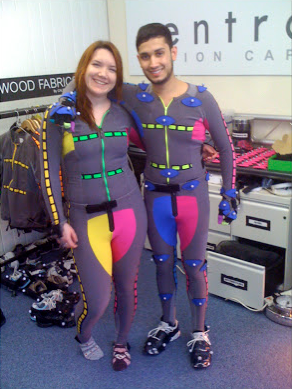Motion capture
Motion capture (often abbreviated as mocap) is the process of recording the movement of objects or people. It is used in entertainment, sports, medical applications, and for validation of computer vision and robotics. In filmmaking and video game development, it refers to recording actions of human actors and using that information to animate digital character models in 3D computer animation.
History[edit | edit source]
Motion capture has its roots in the early 20th century with the work of Eadweard Muybridge and Étienne-Jules Marey, who used sequential photography to study human and animal motion. The modern form of motion capture began in the 1970s with the development of optical systems that could track reflective markers placed on a subject.
Technology[edit | edit source]
Motion capture technology can be divided into several categories:
Optical Systems[edit | edit source]
Optical systems use cameras to track markers placed on the subject. These markers can be passive (reflective) or active (LEDs). The data from the cameras is then processed to create a 3D representation of the subject's movements.
Inertial Systems[edit | edit source]
Inertial systems use accelerometers and gyroscopes to track the movement of the subject. These systems do not require external cameras and can be used in a wider range of environments.
Magnetic Systems[edit | edit source]
Magnetic systems use sensors to detect the position and orientation of the subject within a magnetic field. These systems can be affected by metal objects and other magnetic fields in the environment.
Mechanical Systems[edit | edit source]
Mechanical systems use exoskeletons or other mechanical devices to track the movement of the subject. These systems can provide very accurate data but can be cumbersome to wear.
Applications[edit | edit source]
Motion capture is used in a variety of fields:
Entertainment[edit | edit source]
In the entertainment industry, motion capture is used to create realistic animations for films, television, and video games. Notable examples include the character Gollum in The Lord of the Rings film series and the video game L.A. Noire.
Sports[edit | edit source]
In sports, motion capture is used to analyze and improve athletic performance. It can be used to study the biomechanics of athletes and to develop training programs.
Medical Applications[edit | edit source]
In medicine, motion capture is used to study human movement and to develop treatments for conditions such as cerebral palsy and Parkinson's disease. It is also used in rehabilitation to track the progress of patients.
Robotics[edit | edit source]
In robotics, motion capture is used to develop and test algorithms for robot motion and to validate the performance of robotic systems.
Related Pages[edit | edit source]
See Also[edit | edit source]
References[edit | edit source]
External Links[edit | edit source]
Search WikiMD
Ad.Tired of being Overweight? Try W8MD's physician weight loss program.
Semaglutide (Ozempic / Wegovy and Tirzepatide (Mounjaro / Zepbound) available.
Advertise on WikiMD
|
WikiMD's Wellness Encyclopedia |
| Let Food Be Thy Medicine Medicine Thy Food - Hippocrates |
Translate this page: - East Asian
中文,
日本,
한국어,
South Asian
हिन्दी,
தமிழ்,
తెలుగు,
Urdu,
ಕನ್ನಡ,
Southeast Asian
Indonesian,
Vietnamese,
Thai,
မြန်မာဘာသာ,
বাংলা
European
español,
Deutsch,
français,
Greek,
português do Brasil,
polski,
română,
русский,
Nederlands,
norsk,
svenska,
suomi,
Italian
Middle Eastern & African
عربى,
Turkish,
Persian,
Hebrew,
Afrikaans,
isiZulu,
Kiswahili,
Other
Bulgarian,
Hungarian,
Czech,
Swedish,
മലയാളം,
मराठी,
ਪੰਜਾਬੀ,
ગુજરાતી,
Portuguese,
Ukrainian
Medical Disclaimer: WikiMD is not a substitute for professional medical advice. The information on WikiMD is provided as an information resource only, may be incorrect, outdated or misleading, and is not to be used or relied on for any diagnostic or treatment purposes. Please consult your health care provider before making any healthcare decisions or for guidance about a specific medical condition. WikiMD expressly disclaims responsibility, and shall have no liability, for any damages, loss, injury, or liability whatsoever suffered as a result of your reliance on the information contained in this site. By visiting this site you agree to the foregoing terms and conditions, which may from time to time be changed or supplemented by WikiMD. If you do not agree to the foregoing terms and conditions, you should not enter or use this site. See full disclaimer.
Credits:Most images are courtesy of Wikimedia commons, and templates, categories Wikipedia, licensed under CC BY SA or similar.
Contributors: Prab R. Tumpati, MD


